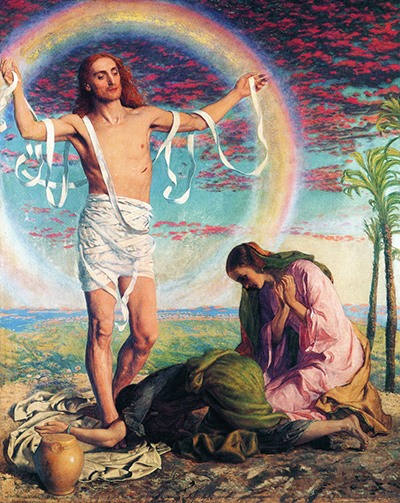This luminous painting by the noted Pre-Raphaelite, William Holman Hunt, is a curiosity in that it is a painting with a foot in both parts of Hunt's painting life.
Originally begun in 1847, Hunt felt he lacked the religious conviction to do the subject justice. He returned to it in 1897, having developed into a painter for whom religion became a recurring theme.
In it, the risen Christ presents himself to the two Marys; his mother and Mary Magdalen, the witness to his resurrection. The painting is set in the garden of Joseph of Aramithea.
It depicts a moment shortly after the resurrection. Christ's wounds are still visibly bleeding, and the bandages in which his corpse was wrapped hang from him in tatters. Hunt was a believer in symbolism, and it's clear here that in casting off these bandages, Jesus is casting off death itself.
As befits one of the pre-eminent Pre-Rapahelites, this painting displays many of the hallmarks of their work. The painting seems to glow with an inner light (perhaps the light of the Redeemer himself).
The use of colour is vivid and striking, from the halo surrounding the central figure of Jesus to the impossible, deep red of the clouds behind. Indeed, all of the landscape behind Jesus is depicted in colours which seem scarcely credible, such is their intensity. It is as if the halo through which he is stepping is refracting the light, bathing the valley behind Jesus with an unearthly tint.
There is also the notable Pre-Raphaelite attention to detail. Hunt and his fellow Pre-Raphaelites, Millais and Rossetti, set great store by the hyperrealism of their paintings, disdaining the abstract or impressionistic.
As a much later work there are elements of the landscape which wouldn't have appeared in Hunt's earlier pieces; but the attention to detail remains foregrounded, from the granular texture of the soil to the billowing texture of the Marys' clothing. It is as if Hunt is saying this is here, this is real. The attention to texture grounds Jesus Christ as part of the everyday world.
This is a painting which marks a journey both stylistically and thematically from William Holman Hunt's roots. Arguably it's the end of the road he started down when he painted "The Light of the World". Certainly it's a vibrant, soulful late William Holman Hunt painting.




